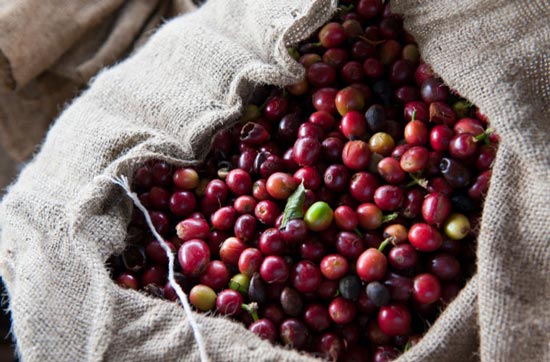Description of planting Information and Flavor of single Coffee Bean in Uganda

Professional barista communication, please pay attention to coffee workshop (Weixin Official Accounts cafe_style )
Uganda is the mother of African Romuda and in recent years has also produced excellent high-altitude Arabian species.
In 1860, Romstad coffee was discovered around Lake Victoria, and to this day, there are still wild Romstad coffee.
Arabic species were introduced from Malawi in Southeast Africa in the early 20th century, and Arabic species were mainly planted in Bugishu region (along the slope of Mount Elgon) and Wugars region. The areas, grades and labels of Arabic species sold were Bugisu AA, Bugisu A (washed above), Wugar A (washed above), and a small amount of sun-dried beans Drugar.
93% of the country's total coffee production is raw beans, which are exported to earn foreign exchange (including Arabic and Romanian).
The main harvest period of Arabian species is from October to February of next year, and the secondary harvest period is in August;
Luozhong (north of the equator): October to February; Luozhong (south of the equator): May to August
Arabian species are mainly cultivated as Bourbon and Kent (but in recent years, improved new species have been tested)
Basic information of Bugishu in this batch:
Country: Uganda Region: Bugishu (also written Bugisu), northeast slope of Mount Elgon
Label: Bugishu Grade: AA Variety: Unlabeled Harvest Date: October 2004
Treatment: Water washing method (fermentation cleaning, sun drying) Appearance/defect: green, 1D/350G
Cup test: one burst of beans in the middle, i.e. osher M0 baking degree, cinnamon baking degree
Dry fragrance: grass fragrance, sweet fruit, nut fragrance
Wet fragrance: caramel sweet, flower and fruit fragrance, spice flavor
Sip: Cocoa-like bitter sweet taste, spice taste, acid is not bright belongs to soft type, fruit sweet taste, fat feeling sticky thick, tea astringent feeling will stimulate saliva produced spice sweet feeling is very special, caramel sweet obvious.
Uganda coffee
In Uganda, Arabica coffee beans account for only 10% of the country's coffee production, but they are enough to attract attention. Uganda's best coffee is grown mainly in the Elgon and Bugisu mountains along the Kenyan border in the north and in the Ruwensori mountains in the west, where coffee is available for export in January or February of each year.
The equator crosses Uganda, and the right climate makes it the world's leading producer of robert coffee beans. In the 1960s Uganda's coffee production remained at 3.5 million bags per year. By the mid-1980s, mainly for political reasons, coffee production had dropped to 250 bags a year. But coffee production is picking up again and is now about 3 million bags a year. One of the major problems facing the coffee industry is the lack of good roads to transport coffee to ports such as Mombasa in Kenya or Dar es Salaam in Tanzania.
In order to improve coffee quality and reduce costs, Uganda abolished the exclusive rights of the Coffee Marketing Board (CMB) in November 1990. Most of the work previously undertaken by the Coffee Marketing Committee has now been transferred to cooperative organizations. Privatized coffee generates two-thirds of the country's export revenue, so the government imposed a tax on coffee in the hope of raising much-needed revenue. This has led to a 20% drop in coffee exports and an increase in coffee smuggling.
As in Tanzania, where rising coffee prices in recent years have encouraged farmers to return to plantations and reclaim once-abandoned land for coffee, Uganda's coffee industry looks promising.
Uganda is located at the source of the Nile River and is a landlocked country in Africa without sea. Although it has a long history of producing coffee like other East African countries, the quality of coffee cannot be improved due to wars caused by ethnic rivalries. Most of the good coffee is grown in the areas adjacent to Kenya. Some good coffee beans are shipped to Kenya to be mixed with Kenyan coffee for sale. Uganda did not become a country with rapid coffee development until the war stopped 15 years ago. Uganda is a country rich in lush green forests, lakes, wetlands and rivers. Coffee is the largest crop in Uganda and earns the most foreign exchange. About 500,000 coffee farms are engaged in coffee-related agriculture, accounting for 25% of the total population. Coffee trees are mostly strong growing Robusta coffee trees. Only 6% of coffee trees are traditional Arabica trees. These rare coffee beans grow in tropical rainforests and are mostly exported to countries around the world.
Arabica grade AA coffee beans
Uganda coffee classification is the same as Kenya, AA grade is the best, this classification represents the coffee bean size is consistent and uniform, but this classification system will vary according to the evaluation of each estate, for example, A estate is better than B estate, even if AB beans in A estate will be better than AA beans in B estate, coffee sales adopt two channels of fine auction and direct sales, if strengthen the details of the processing process and the selection of missing beans, I believe that Kenya and Ethiopia can get better sales under the condition of high coffee prices.
Too many empty beans, defective beans and unfermented coffee beans in Uganda make it impossible to improve the quality and get a good harvest and price.
The new season of 2010 introduced from Bugisu (Bugisu) production of coffee grade AA, coffee green beans are dark green from the appearance of green beans can be seen as traditional Arabica beans about 18- 19 mesh size.
Light Baking End (City): After grinding beans, there is obvious peanut and almond aroma. When brewing, the fragrance of fairy grass also has the fermented flavor of sun-dried beans. The taste is thin and not complex. The acidity of the fruit is not strong and sweet quickly. The aftertaste has the aroma of fruit sweet and wheat tea.
Full City: bitter chocolate and almond aromas after grinding, dark chocolate aromas after coffee brewing, spicy aromas, banana pineapple dried fruit sweetness, rich flavor, rich oil ester acid, coffee slightly cold finish rich chocolate flavor to sweet brown sugar water sweet.
Date of cup test: July 9, 2010
Dry aroma: 8
Wet aroma: 8
Clean: 6
Brightness: 7
Taste: 8
Balance: 7
Complexity: 9
Sweetness: 9
Acid: 6
Aftermath: 9
Overall Reviews: Uganda AA-Bujisu has the characteristics of traditional East African Arabica coffee with sweet fruit and rich taste, but fermentation aroma and low acid are relatively rare, is suitable for heavy roasting coffee beans can get rich ester and rich.
East Africa Great Graben (i.e. Rift Valley) connects Victoria Lake with Elgon Mountain, which is a famous and important fine coffee belt in East Africa. The east side of Elgon Mountain belongs to one of Kenya's important coffee producing areas, while the west side of Elgon Mountain, that is, the western highland of Uganda, also produces excellent coffee. This area is Bugishu!
Bugishu, about 5 hours drive from Kampala, is the coffee distribution town of Bigisu, Mbale, where there are many vendors and coffee storage stations, so some exporters will mark "Mbale" as raw beans, followed by a grade, such as AA or A, but still belong to Bugishu district beans;Bugishu coffee farmers are called "Shambas"(sound: Coffee is almost their only cash income, which is used to pay for medical, household and educational expenses…Local small farmers concentrate on small-scale washing during coffee harvest, and then concentrate on Mbale for sale, followed by dry processing and grading.
This batch of Uganda Bugishu AA is very different from Kenya beans in neighboring countries. The acidity is not so bright, and there is no wine fragrance, sweet feeling and spice flavor occasionally appearing in early Bugishu. However, the body is as good as Kenya beans arrived this year!
Bugishu (or Bugisu), which happens to be the East African bean of the Osheben series, finally arrived on the shelf. She is very different from Rwanda and Pulongdi before in aroma or flavor! In terms of acidity, Rwanda is the brightest and most lively, followed by Pulongdi, Uganda's acid is the softest, in terms of taste, the three have their own merits, all belong to the body of the bean type; and aroma, Uganda is the most gentle, Rwanda is the most sharp, Pulongdi most keep their duty, because the harvest period of 2004-2005, East Africa's high altitude high quality beans, in fact, very fragrant, flavor characteristics are also very clear!
Uganda's geographical conditions and climate: Uganda is a landlocked country, not close to the sea, but there is a micro-Doria Lake, neighboring Kenya in the east, Zaire (now the Republic of Congo) in the west, Sudan in the north and Tanzania in the south. Due to the regulation of many mountains and micro-Doria Lake in the country, Uganda crosses both sides of the equator, but the climate is quite mild, which is naturally suitable for planting good coffee.
Important Notice :
前街咖啡 FrontStreet Coffee has moved to new addredd:
FrontStreet Coffee Address: 315,Donghua East Road,GuangZhou
Tel:020 38364473
- Prev

Description of regional flavor of Ugandan coffee beans
Professional baristas exchange please follow the coffee workshop (Wechat official account cafe_style) this batch of Bugishu basic information: country: Uganda production area: Bugishu (also written as Bugisu), the northeast slope of Elgon Mountain marked: Bugishu grade: AA variety: unmarked harvest time: October 2004 treatment: washing method (after fermentation cleaning, picking sunlight and drying)
- Next

Processing method for describing the characteristics of Information and Flavor in the planting area of single Bean and Coffee Bean in Uganda
Professional barista exchanges please pay attention to the coffee workshop (Wechat official account cafe_style) Uganda's geographical conditions and climate: Uganda is an inland locked country, not by the sea, but there is a Weidoria Great Lake, neighboring Kenya to the east, Zaire to the west (now the Republic of the Congo), Sudan to the north and Tanzania to the south, due to the high mountains in the country and the adjustment of Lake Weidoria.
Related
- Detailed explanation of Jadeite planting Land in Panamanian Jadeite Manor introduction to the grading system of Jadeite competitive bidding, Red bid, Green bid and Rose Summer
- Story of Coffee planting in Brenka region of Costa Rica Stonehenge Manor anaerobic heavy honey treatment of flavor mouth
- What's on the barrel of Blue Mountain Coffee beans?
- Can American coffee also pull flowers? How to use hot American style to pull out a good-looking pattern?
- Can you make a cold extract with coffee beans? What is the right proportion for cold-extracted coffee formula?
- Indonesian PWN Gold Mandrine Coffee Origin Features Flavor How to Chong? Mandolin coffee is American.
- A brief introduction to the flavor characteristics of Brazilian yellow bourbon coffee beans
- What is the effect of different water quality on the flavor of cold-extracted coffee? What kind of water is best for brewing coffee?
- Why do you think of Rose Summer whenever you mention Panamanian coffee?
- Introduction to the characteristics of authentic blue mountain coffee bean producing areas? What is the CIB Coffee Authority in Jamaica?

